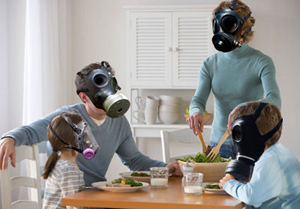November 16, 2009
Chinese Drywall Mess Brings New Focus To Indoor Air Quality Issues

By Michael D. Shaw
On October 29th, the Consumer Product Safety Commission—lead agency in a governmental task force investigating the problem—arranged a media conference call to discuss the results of their report released on that date entitled “Initial Chinese Drywall Studies.” Many observers were hoping for more definitive findings, but some generic points did come out.
Although temporary health effects were acknowledged, air sampling results did not indicate any substances at levels which would be associated with these symptoms. Yet, the symptoms reported were recognized as being in line with what is normally found in cases of residential indoor air contamination. Certain exposure scenarios were identified that could explain some of the temporary symptoms of upper airway and eye irritation. It was also mentioned that mixtures of chemicals in these homes could cause additive or synergistic effects, but there is not a standard way to evaluate these potential effects.
In fact, fully understanding the effects of low-level environmental contaminants (at a given locale) on human health is extremely difficult, because of the many confounding factors. These would include:
- Psychosomatic false positive reactions
- Exposure to toxins outside the home
- Current health of the subject
- Variations in ventilation parameters
- Claimed symptoms are common to a host of causative factors
- Variation in sensitivity to contaminants among different people
On the regulatory side, there is a reluctance to establish a threshold below which a problem would be ignored. This, in itself, can foster continuously decreasing allowable levels for chemicals, based not on data, but on a misguided attempt to protect everyone. And, in a vicious cycle, the existence of an already very low permissible level promotes imaginary symptoms among those who believe they are in such an environment, thus promoting even lower regulatory levels.
But beyond tainted drywall, there is renewed interest in the overall matter of indoor air quality.
At the recent annual meeting of the American College of Allergy, Asthma and Immunology, experts noted that “Damp environments, poorly maintained heating and air-conditioning systems, and carpeting may contribute to poor indoor air quality.” Too high a humidity was cited as a key factor by building scientist Doug Garrett: “Moisture leads to conditions that are conducive to dust mites and mold, as well as bacteria, yeast, and other living organisms.”
In light of the emerging theory of bacterial etiology of tainted drywall, this gives one pause. Garrett also reminds us that even if someone is not allergic, molds may produce mycotoxins and volatile organic chemicals that not only smell bad, they can also cause respiratory irritation.
Indoor air quality guru Bud Offerman was the principal investigator on a study completed in 2008 entitled “Ventilation and Indoor Air Quality in New California Homes.” There were some disturbing findings…
- Many homeowners never open their windows or doors, especially in the winter months.
- Natural air infiltration rates in new California homes can be as low as 0.1 air changes per hour (ACH).
- 67% of the homes had outdoor air exchange rates below the minimum code requirement of 0.35 ACH.
- Low outdoor air exchange rates can drive concentrations of air contaminants above recommended exposure guidelines.
To put these ACH figures in perspective, note that standards for commercial buildings are far higher, ranging from a minimum of 1.0 to 6.0, depending on type of occupancy. For special circumstances such as commercial kitchens, the number can be as high as 60.
Northern California based industrial hygienist Linda Kincaid has looked into residential formaldehyde levels, especially as this relates to structures deemed “energy efficient.” One rating organization prides itself that its certified homes are typically 15% more energy efficient than conventional homes built to current building codes. Ironically, this same organization also encourages the use of engineered wood to reduce consumption of virgin timber.
Engineered wood products contain formaldehyde resins, and the chemical can be emitted from these items when they are new. Combine this with poor ventilation, and you could have a problem, or at least levels that are higher than encountered in a less tight home. Kincaid’s field measurements bear this out, but require further confirmation.
She emphasizes that “[B]uildings are for people, and health must trump energy conservation. Buildings, including residences, need to be designed and built to provide a healthy indoor environment, while striving for energy efficiency and sustainability.
True enough, and the introduction of tainted drywall certainly does not help.

